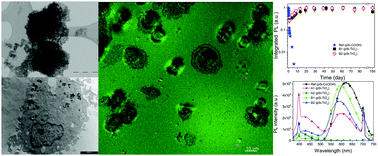TiO2-coated luminescent porous silicon micro-particles as a promising system for nanomedicine†
Abstract
Porous silicon (pSi) is a sponge-like material obtained by electrochemical etching of a crystalline silicon wafer. Due to quantum confinement effects, this material is photoluminescent and this is a fundamental property from the perspective of bioimaging applications. Limitations in nanomedicine to the use of photoluminescent pSi structures are mainly due to optical quenching in an aqueous environment and to the adverse effects of reactive groups introduced by etching procedures. In this work, we exploited an inorganic TiO2 coating of pSi microparticles by Atomic Layer Deposition (ALD) that resulted in optical stability of pSi particles in a biological buffer (e.g. PBS). The use of a rotary reactor allows deposition of a uniform coating on the particles and enables a fine tuning of its thickness. The ALD parameters were optimized and the photoluminescence (PL) of pSi–TiO2 microparticles was stabilized for more than three months without any significant effect on their morphology. The biocompatibility of the coated microparticles was evaluated by analyzing the release of cytokines and superoxide anion (O2−) by human dendritic cells, which play an essential role in the regulation of inflammatory and immune responses. We demonstrated that the microparticles per se are unable to significantly damage or stimulate human dendritic cells and therefore are suitable candidates for nanomedicine applications. However, a synergistic effect of the microparticles with bacterial products, which are known to stimulate immune-response, was observed, indicating that a condition unfavorable to the use of inorganic nanomaterials in biological systems is the presence of infection diseases. These results, combined with the proved PL stability in biological buffers, open the way for the use of pSi–TiO2 microparticles as promising materials in nanomedicine, but their ability to increase immune cell activation by other agonists should be considered and even exploited.



 Please wait while we load your content...
Please wait while we load your content...